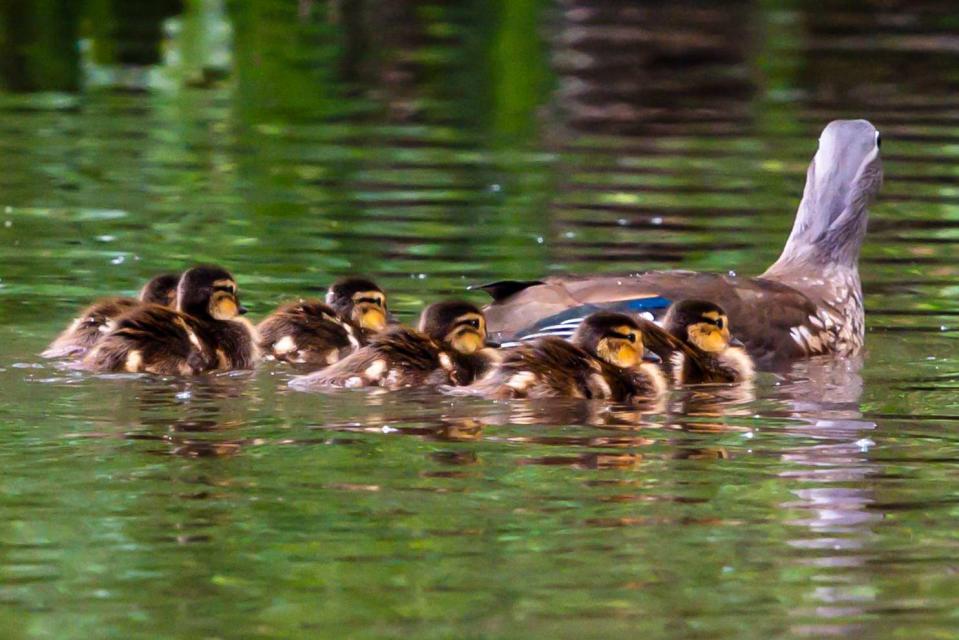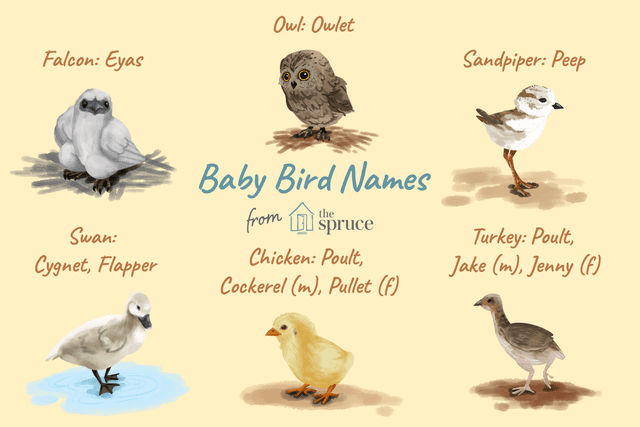Naming Baby Birds by Size and Species
Plus what to do if you find one outside the nest

The Spruce / Giuseppe Intrieri
Other than cute, adorable, and charming, what are baby birds called? Baby birds are special in many ways. They use specific sounds to get attention, they have unique behaviors to beg for food, they have soft down feathers to keep warm, and they are camouflaged to keep safe. It is no surprise, then, that there are special names for baby birds, including terms that refer to young birds of certain families. Knowing those terms can help birders refer to baby birds properly in their notes, when contacting bird rescue centers or birding organizations, or just to have fun when talking about birds.
If you see a baby bird, it's likely a fledgling or nestling. These baby birds that seem abandoned are seldom left alone for long because they are typically under a parent's watchful eye.
Generic Names for Baby Birds
Several generic names can refer to any baby bird, from ducks to raptors to songbirds to shorebirds. The term "chick" is the most common and can describe any baby bird of any species from the moment it hatches until it leaves the nest. There are other generic terms, however, that can also be used with baby birds of different ages.
Hatchling: A hatchling is a very recently hatched baby bird that does not yet have more than sparse down and may not have open eyes or any ability to care for itself. This term is most frequently used to refer to altricial chicks that are born nearly naked.
Nestling: A nestling is a young bird that is several days old and covered with fluffy down. These birds are more active and demanding but are not yet ready to care for themselves. They may be beginning to grow flight feathers but cannot leave the nest or go without parental care.
Fledgling: A young bird that has developed most of its flight feathers and is very nearly ready to leave the nest is called a fledgling. These young birds may remain under parental care for some time after actually vacating the nest. These birds are awkward and inexperienced. They do not fly well but may hop around eagerly.
Juvenile: A juvenile bird has grown past the most awkward youth stages but is not yet a mature adult. Juvenile birds may look similar to adults but still show some of the camouflage of their youth, and their field marks may not be as well-defined as mature birds.
Subadult: A subadult bird is an immature bird that, while it has left the nest and completely cares for itself, is not yet sexually mature and lacks all the distinct field marks of adults. Larger birds, such as gulls and eagles, take several years to fully mature, and subadult plumage stages can be confusing for many birders to identify.

Baby Bird Names for Specific Bird Families
While generic names for baby birds can be used for any bird species, specific bird families have more unique names for their young. The most popular names for baby birds include:
Chicken: Poult, cockerel (male), pullet (female)
Crane: Colt
Dove: Squab, squeaker
Duck: Duckling
Eagle: Eaglet
Falcon: Eyas
Goose: Gosling
Grouse: Cheeper, squealer
Guineafowl: Keet
Loon: Loonlet
Owl: Owlet
Puffin: Puffling
Sandpiper: Peep
Swan: Cygnet, flapper
Turkey: Poult, jake (male), jenny (female)
The exact bird species is irrelevant when using these baby bird names: a baby bald eagle is an eaglet, and a baby Steller's sea eagle is an eaglet as well. To distinguish between species, terms like "bald eaglet" or "Steller's sea eaglet" might be used, or the birds can be referred to by species with a more generic term, such as "bald eagle chick."
If you use more specific baby bird names, be aware that these terms are typically only used when the birds are young. After they have left the nest or family group and are caring for themselves, even if they are not yet fully mature, they are no longer referred to by their baby names.
If You See a Baby Bird
No matter what you call it, seeing a baby bird can be exciting. Their charming behavior is designed to elicit the attention and sympathy of their parents, and those same behaviors are just as effective on humans. If you find a baby bird, however, the best course of action is to leave it alone so its parents can care for it. But if you do spot an owlet, squab, flapper, or chick:
Keep your distance. Approaching the bird closely will cause it more stress and may keep parent birds from returning as regularly to care for it. If you get too close to a baby bird, you may also scare it into moving to a less suitable, unsafe area.
Do not feed it. It can be tempting to offer a begging baby bird a treat, but baby birds have very specific dietary needs. Foods meant for adult birds, including birdseed, fruit, worms, and nuts, can choke baby birds, and do not provide the proper nutrition for growth and development. Instead, leave the baby bird alone and its parents will see that it gets fed.
Protect the area. Keep pets and small children indoors, and do nothing that could draw attention to the young bird and make it more vulnerable to predators. If the area is unsafe, gently move the baby bird to a safer spot, such as under a dense bush where it will be more concealed and shaded from hot sun or drenching rain.
Contact a rehabber if necessary. If the baby bird appears sick, injured, or in distress, or if the parent birds have not returned in several hours to care for it, contact a bird rescue organization so the baby can receive proper care.
From tiny chicks to nearly mature subadults, baby birds are always fun to see, and it's even more fun when you know just what to call baby birds of different species. Understanding these young birds can help you get even more enjoyment out of birding during the breeding season.

